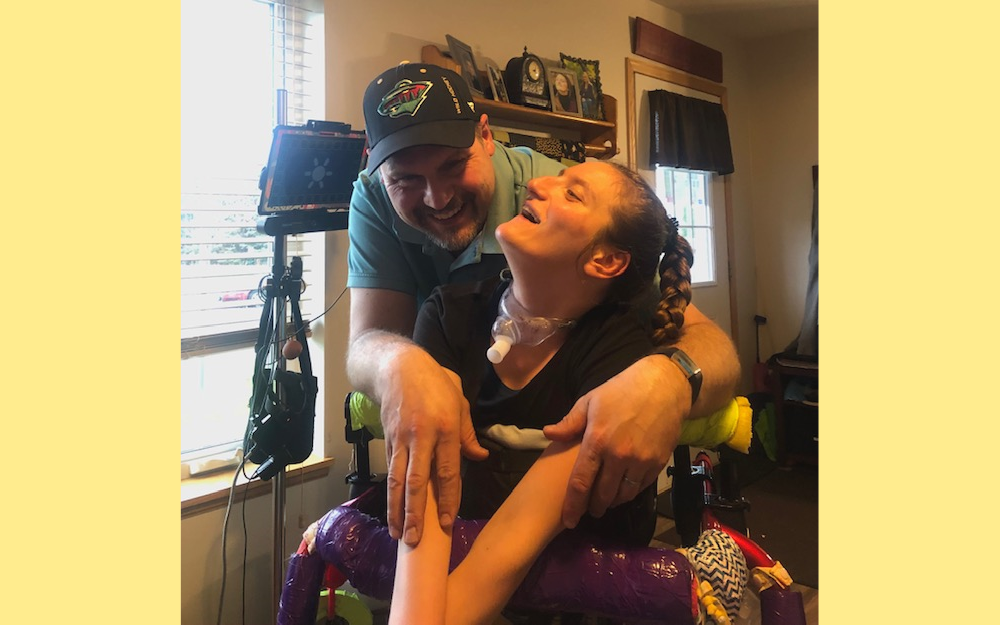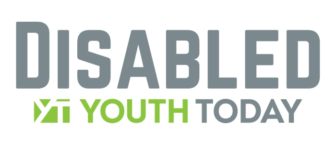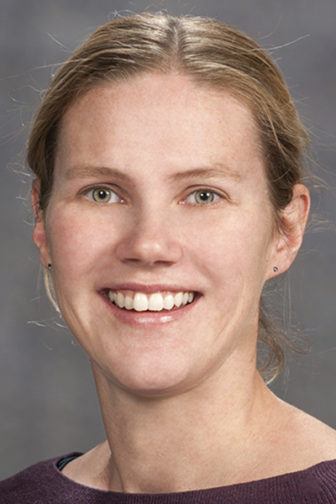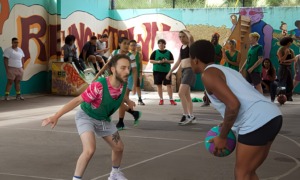
Hanson Family
Alex Hanson, 20, with her father, Kyle Hanson
Alex Hanson, 20, has cerebral palsy, a breathing tube, two feeding tubes and round-the-clock nursing care. More than a month into her home state of Minnesota’s rollout of the COVID-19 vaccines, Hanson’s able-bodied mom was alerted that, as one of her child’s official caregivers, she was in a class of essential workers eligible to get that shot. But her daughter still wasn’t eligible.
“She gets pneumonia easily and she’s on the ventilator at night … We were terrified,” said Kyle Hanson, Alex’s father, referring to the coronavirus. “Alex was, basically, the prime candidate of somebody who would die if they got it.”
 Alex’s mother made her own appointment, brought Alex along, and told the health-care workers on site that she and her daughter had to get the vaccine. Alex, who cannot talk, got her first shot that day, and has since received her second shot. Recently, she returned to school for two days a week.
Alex’s mother made her own appointment, brought Alex along, and told the health-care workers on site that she and her daughter had to get the vaccine. Alex, who cannot talk, got her first shot that day, and has since received her second shot. Recently, she returned to school for two days a week.
For others with disabilities, things turned out much differently. Vincent Welch, a 36-year-old Michigan man with Down syndrome, contracted COVID-19 in March, days before health officials in his home state had set March 22 as the vaccination eligibility date for people with his and several other disabilities. Welch died on April 16 of complications from the disease, after a hospitalization that included more than a week on a ventilator.
“That’s all he talked about is getting a shot,” his mom, Susan Welch, told The Daily Beast.
A Patchwork Vaccine Rollout
Experts and advocates for persons with disabilities say that failing to include Hanson, Welch and other disabled people in the first round of coronavirus vaccines is part of a long pattern of health care neglect. With potentially deadlier variants of the coronavirus emerging and medical clinicians now discussing whether COVID-19 booster shots will be needed, experts and advocates also are underscoring the importance of organizing politically to ensure people with disabilities aren’t pushed to the back of the line again.
“The ADA exists exactly for times like this,” Sara Curfman, executive director of the Down Syndrome Association of Minnesota, said, referring to the Americans With Disabilities Act. “When we talk about where you see instances of discrimination, it is typically when something is a scarce resource.”
At the outset of COVID-19 vaccinations, Curfman added, many states seemed to prioritize quickly getting shots in as many arms as possible, rather than figuring out who actually was most at risk medically.
The federal Centers for Disease Control made recommendations about how to allocate vaccines, but the final decisions of that were left up to states. The result was a patchwork rollout that saw some people with high-risk conditions get the vaccine in their state, while, on the other side of state lines, persons with the same conditions were forced to wait.
Data showed, for example, that people with intellectual disabilities were particularly at risk. A meta-analysis of several prior studies involving almost 65 million patients, published in the New England Journal of Medicine Catalyst in March 2021, found that having an intellectual disability was the single strongest independent risk factor for catching COVID-19, and, after age, the second strongest factor linked to dying as a result of the coronavirus. Yet, the vaccine rollout in many states failed to properly prioritize those with intellectual disabilities, a population that includes some with physical disabilities, too.
In Minnesota, Curfman said, that meant that getting people with Down syndrome access to the vaccines “became a very tribal fight,” won primarily by intensely lobbying state lawmakers and other government officials.
The fight echoed previous battles, including the right for persons with disabilities to have an equal, adequate education or to live in their communities rather than institutions. Curfman said that, early on, the vaccine rollout landed on a continuum that appeared to bestow less value on disabled lives than those of non-disabled Americans.
How to Prepare for the Future
When states began opening up vaccine appointments to large groups in February, many directed vaccine-seekers to government-run websites that were not always accessible to persons with disabilities. Some, for example, weren’t configured to work with screen readers that people with visual impairments depend upon. Even now, with a significantly greater supply of available vaccines, the shots remain out of reach for many of the 4 million homebound Americans whose conditions, including Parkinson’s and multiple sclerosis, limit their ability to get to a vaccination site.

Dr. Katherine “Katie” Foss, professor of media studies and strategic communications, School of Journalism.
Katie Foss, a journalism and strategic communications professor at Middle Tennessee State University who has studied previous epidemics, said past vaccine rollouts were more equitable. That’s because they were massive, coordinated public health campaigns that weren’t subject to a “digital divide.”
“You didn’t have to figure out how to log in to a computer, find a site, then find a spot and be guaranteed … if you have vision issues, that it’s a screen reader-accessible site,” said Foss, author of “Constructing the Outbreak: Epidemics in Media and Collective Memory.” “There was none of that. It was very clear how you would access vaccines.”
With the COVID-19 vaccine, there was less of a collective public effort to get everyone vaccinated, she said, creating a winner-take-all rollout that often left disabled people behind.
“It was choppy and disjointed and lacked the coordinated effort to make, first of all, the vaccine sign-up easy to use,” Foss said. “The prioritization itself was confusing, especially, because it differed by state. I would say it all demonstrated the need for a unified collective effort.”
Some states built their early vaccine prioritization plans solely by putting the oldest people at the front of the line. Medically, that made very little sense, wrote a trio of experts in law and medical ethics in a March 2021 Washington Post opinion essay.
“Age-only distribution is unethical, likely illegal and bad health policy,” wrote Govind Persad of the University of Denver and Emily Largent and Ezekiel Emanuel of the University of Pennsylvania. “It also abdicates the government’s responsibility to seek equity and proactively reach out to high-risk people in search of the mirage of value neutrality. Simplicity and speed are valuable, but equity and fairness should not be abandoned in the pursuit.”
Research has suggested that people with Down syndrome, even if they were younger, had a legitimate medical need to get the vaccine early. Studies show they are four times more likely than the general population to be hospitalized if they catch COVID-19 and 10 times more likely to die of it. Citing that data, advocacy groups in Ohio successfully pushed to make residents with Down syndrome as young as 16 eligible for the vaccine in late January, according to the Columbus CBS affiliate.
Curfman said Minnesota officials, initially, seemed intent on following CDC guidelines, which meant the people her organization represents had to wait until several other groups had been vaccinated before they could get their shot.
“We were really stressed out … as we saw most states move to a place where they said, ‘Hey, there’s some really high-risk groups that need to be prioritized,’” Curfman said.
Under pressure from Curfman’s group and others, Minnesota officials eventually changed their criteria to give people with certain disabilities earlier access to the vaccine. The same thing happened in California, where the state moved up in line younger people with disabilities that put them at high risk. Initially, those West Coast officials had set up a tiered-system more based on age and job types that heightened risks for certain workers.
Curfman said she was glad that Minnesota officials eventually heeded calls to open up vaccines for people with Down syndrome. When they did, she added, it seemed like the state actually had enough supply and a workable distribution plan to promptly schedule vaccination appointments, which wasn’t the case in every state.
“You’d hope that it was based on, ‘What is the person’s risk of bad health outcomes?’ Not just the risk of getting it, but the risk of not doing well when they got it,” Curfman said. “And that is not where the conversation started. I do believe that that is where the conversation is now.”
Feeling a “sense of relief”
Kyle Hanson, the father of that 20-year-old with cerebral palsy, said his family was similarly vocal about trying to get her the vaccine, eventually writing an appeal to the state’s governor.
The Hansons didn’t initially think it would take that much effort, given how early and readily people in nursing homes were being vaccinated. Alex was on Minnesota’s Community Alternative Care Medicaid waiver, a program certifying that her medical needs would qualify her for nursing home care and allowing her to receive that level of care at home instead.
Hanson said it seemed as if the rationale for the different treatment was that Alex was at less risk of being exposed to COVID-19 at home than she would be in a nursing home.
“They figure she’s home and she’s safe,” Hanson said. “But we have nursing coming and going all the time, out of necessity, and we can’t just seclude her.”
Yet, Hanson said, in the frantic lead-up to ensuring Alex got the vaccine, whenever Hanson or his wife called Alex’s team of five doctors, they were either told the medical professionals weren’t sure when Alex would be eligible, or that she wouldn’t be eligible until the general population was.
“And in our minds, Alex is definitely not general population,” Hanson said. “She lives at home, but she could be in a nursing home, she could be in a hospital. Her cares are [so] complex that she needs one-on-one nursing twenty-four hours a day.”
Hanson said that, in a way, it seemed like his family was being penalized for taking care of Alex at home, rather than putting her in a nursing home. That was not the first time he’d felt that way.
“We’ve been told how much more expensive it is to institutionalize her, versus keeping her at home. But they don’t do a whole lot to help us keep her at home,” Hanson said. “We’re just kind of forgotten about. It’s just kind of, like, ‘Oh, you want her at home, you deal with it and take care of everything.’”
Getting Alex access to the vaccine was a task that similarly fell to the family. Hanson said he’s just glad it’s over.
“It’s a huge sense of relief,” Hanson said. “For the last year, it’s been stressful, thinking, ‘Is today the day she gets it?””





























